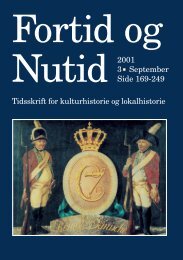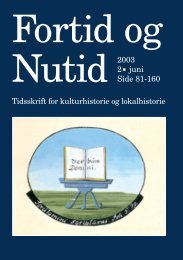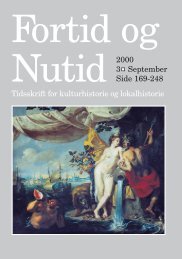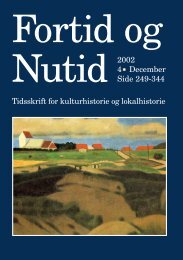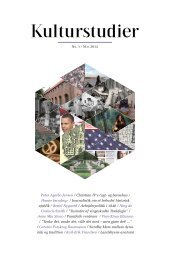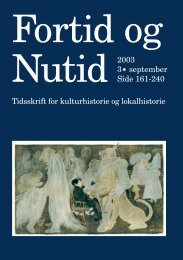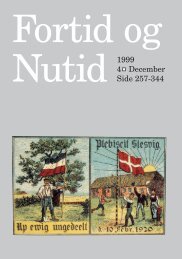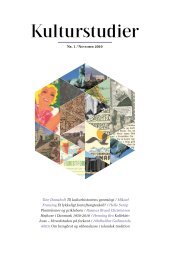Læs hele tidsskriftet (PDF) - Kulturstudier
Læs hele tidsskriftet (PDF) - Kulturstudier
Læs hele tidsskriftet (PDF) - Kulturstudier
You also want an ePaper? Increase the reach of your titles
YUMPU automatically turns print PDFs into web optimized ePapers that Google loves.
<strong>Kulturstudier</strong> Nr. 2, 2011 The reconfigured body<br />
2/15<br />
Introduction<br />
Modern biotechnology is a central field where different biological objects are<br />
reconfigured in a creative act. Examples are gene and stem cell technology,<br />
which have created new values of objectification and materialisation of the human<br />
body, as well as new and expanded markets for the biotechnology industry.<br />
The relation between medical research and industry has not only produced new<br />
diagnostic methods and treatments, but has also projected the scientists’ values<br />
onto the public, in regard to how they relate to the human body. 1 Biotechnological<br />
research provides a good opportunity to study, from a cultural perspective,<br />
how new technologies reconfigure bodies into new states. 2 In the article, the term<br />
’reconfiguration’ is used to study the evolving relationship between human and<br />
animal bodies, and how these bodies alter the manner in which we might refer<br />
to them. 3<br />
The article is based on a study of Swedish scientific work with xenotransplantation<br />
in the 1990s: A biotechnology where cells, tissue and organs from animals<br />
are transplanted to humans. 4 The Swedish case is used to study how the field<br />
of xenotransplantation evolved in the 1990s, as well as how human and animal<br />
bodies were reconfigured in the process. 5 In xenotransplantation, this reconfiguration<br />
concerns not only the human body, but also the animal body, which is produced<br />
and recharged with new values and new understandings. 6 This is evident<br />
in the perspectives taken by actor-network theory (ANT), where the nonhuman<br />
actors; animal cells, tissue and organs, have an energy that can affect human<br />
actors. 7 As researchers transform and transplant these nonhuman actors to patients,<br />
the patient’s body becomes a part of a wider network of other actors, and it<br />
is within this wider network that the relationships between different bodies are<br />
1 Martin 1994.<br />
2 Gilbert 2008; Lederer 2008.<br />
3 Berg and Timmermans 2000; Bowen 2005; Olesen and Markussen 2003.<br />
4 The article reports on work carried out as part of the project ‘Impact of Citizen Participation on Decision-<br />
Making in a Knowledge Intensive Policy Field’ (CIT-PART, Project Nr. SSH-225327), which is funded within<br />
the 7th Framework Programme from 2009–2012. I thank the European Commission for their generous<br />
support of this research project. More information is available at the project website .<br />
5 In the beginning of the 1990s Swedish researchers were at the forefront of international xenotransplantation<br />
research. At Karolinska University Hospital, researchers carried out clinical trials in which ten patients<br />
with diabetes underwent transplant surgery with pig cells producing insulin. At Sahlgrenska University<br />
Hospital, Gothenburg, researchers carried out two clinical trials where a pig kidney was connected to a<br />
patient and the human blood streamed through the kidney. At the time Sweden had between 10 and 15<br />
scientific groups that were working in international networks within this medical science. For a presentation<br />
of the development of xenotransplantation in Sweden and internationally, see Brown and Beynon-<br />
Jones 2010; Deschamps et al. 2005; Lanza and Cooper 1998; McLean and Williamson 2005; Persson and<br />
Welin 2008; SOU 1999:120.<br />
6 Fox 2005; Twine 2010.<br />
7 Berg and Timmermans 2000; Latour 1992.<br />
143



